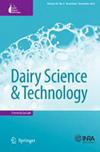意大利巴西利卡塔波多利卡品种牛奶和Caciocavallo奶酪的研究
Q2 Agricultural and Biological Sciences
引用次数: 1
摘要
对巴西利卡塔地区(意大利南部)Podolica牛的牛奶和caciocavallo奶酪进行了一项研究,以期可能确定有助于保护它们免受模仿的特定性状。在春季和初夏期间,从登记在该品种家谱册上的奶牛身上采集了800多个单独的牛奶样本和29个散装牛奶样本;此外,在同一地理区域采集了18个caciocavallo奶酪样本,其中9个是用Podolica牛奶制造的。所获得的结果证实了Podolica牛奶对奶酪制作的高资质,尽管与文献数据相比,采样期间异常干燥的天气降低了脂肪含量。α-乳清蛋白变体A的存在,是波多利卡牛奶的一个特征,在研究中只有14%的动物被确定,这表明这一特征在研究群体中正在消失。由于鉴定出了一些可能的特殊特征,如较低的蛋白质与脂肪比和一些香气描述符,因此对caciocavallo的研究结果提供了有用的指示。需要更多的研究来评估这些特征是否可以用于开发多功能协议,以扩展到所有意大利波多利卡人,能够区分奶酪和仿制品。从这个角度来看,提高α-乳清蛋白变异A频率的选择策略的应用应该仔细评估。本文章由计算机程序翻译,如有差异,请以英文原文为准。
A Study on Milk and Caciocavallo Cheese from Podolica Breed in Basilicata, Italy
A study was undertaken on milk and caciocavallo cheese from Podolica cattle in the Basilicata Region (Southern Italy), with a view of the possible identification of specific traits useful to protect them from imitations. More than 800 individual milk samples and 29 bulk milk samples were taken in spring–early summer from cows registered in the genealogical book of the breed; moreover, 18 samples of caciocavallo cheese were taken in the same geographical area, 9 of which had been manufactured from Podolica milk. The obtained results confirmed the high aptitude of Podolica milk to cheesemaking, even though the exceptional dry weather in the period of sampling decreased the fat content with respect to the literature data. The presence of the variant A of α-lactalbumin, a characteristic trait of Podolica milk, was ascertained in only 14% of the animals considered in the study, indicating that this feature is disappearing in the population under study. The results on caciocavallo gave useful indications, because some possible peculiar characteristics were identified, such as the lower protein to fat ratio and some aroma descriptors. More research is needed to assess if these characteristics can be used for developing a multi-functional protocol, to be extended to all Italian Podolica populations, able to discriminate the cheese from imitations. In this perspective, the application of selection strategies for increasing the frequency of the variant A of α-lactalbumin should be carefully evaluated.
求助全文
通过发布文献求助,成功后即可免费获取论文全文。
去求助
来源期刊

Dairy Science & Technology
农林科学-食品科技
CiteScore
2.30
自引率
0.00%
发文量
0
审稿时长
2 months
期刊介绍:
Information not localized
 求助内容:
求助内容: 应助结果提醒方式:
应助结果提醒方式:


